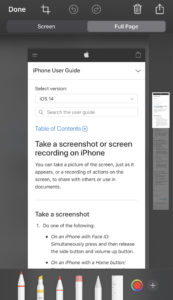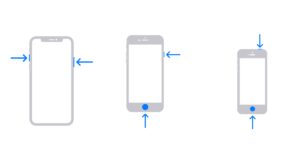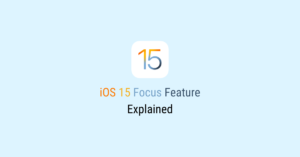We all find ourselves taking screenshots on our devices from time to time. After all, as is written in the human DNA, a picture is worth a thousand words. In this rainy day post, we look at taking screenshots on the iPhone.
How to Take Screenshots on iPhone
On iPhone models with Face ID, press the side power button and the volume up button at the same time, and quickly release both buttons to take a screenshot.
On iPhone models with a Home button and a side or top power button, press the Home button and the side or top button at the same time, and quickly release both buttons to take a screenshot.
After you take a screenshot, a thumbnail temporarily appears in the lower-left corner of the screen. From there you can tap the thumbnail to open and edit the screenshot, or you can swipe left to dismiss it. Apple offers a few tools for highlighting, adding texts, and even adding your signature.
If all you want is to grab the screenshot with no editing, you can swipe left to dismiss the thumbnail. If you just leave it there, the thumbnail will dismiss itself. Either way, you will be able to find the screenshot in your Photos library.
Single Screen Screenshots and Full-page Screenshots
Starting in iOS 13, iPhone users are able to take full-page screenshots. However, full-page screenshots are only available for webpages, documents, and emails, which translate to Apple’s Safari, Pages, and Mail apps. Full-page screenshots are saved as PDF files.
As an example, if you have content that goes beyond your screen in Safari, taking a screenshot will give you the option to choose between Screen and Full Page. If you choose Screen, you get an image to save to the Photos or Files app. Choosing Full Page will allow you to save the webpage as a PDF document.

Bonus Tip and Tricks
Use Back Tap to Take Screenshots
Pressing two buttons to take a screenshot sounds easy enough, but there’s something that’s even easier. Newly available in iOS 14, Back Tap allows users to tap the back of the iPhone twice or three times to perform certain actions.
To set up Back Tap for screenshots, go to the Settings app, then Accessibility, and then Touch. At the bottom, tap Back Tap, choose either Double Tap or Triple Tap and select Screenshot under System.

Remove the Status Bar When Cropping the Screenshot
A lot of the times when you take a screenshot and share it with someone, you want the focus to be on the screen and not necessarily things that might be distracting, like the status bar on the top.
While a screenshot that’s already in the Photos app could be difficult to manipulate, a fresh screenshot allows you to remove the status bar with precision and ease. As soon as you take the screenshot, tap the thumbnail to bring up the edit view and drag the top corners to crop the image. Notice when you drag close to the bottom of the status bar, the bound will snap right to it, let go of the cropping control and that will remove the status bar.
However, there are two catches.
First, as we have already mentioned, this is only available before the screenshot is saved to the Photos or Files app. Editing the image in the Photos app with not replicate the snapping effect.
Second, this is not available for screenshots of the Home Screen or the Lock Screen. Between this second catch and only allowing users to take full-page screenshots in certain apps, Apple maintains tight control of their products’ appearance, software included, in places their users don’t even realize.

